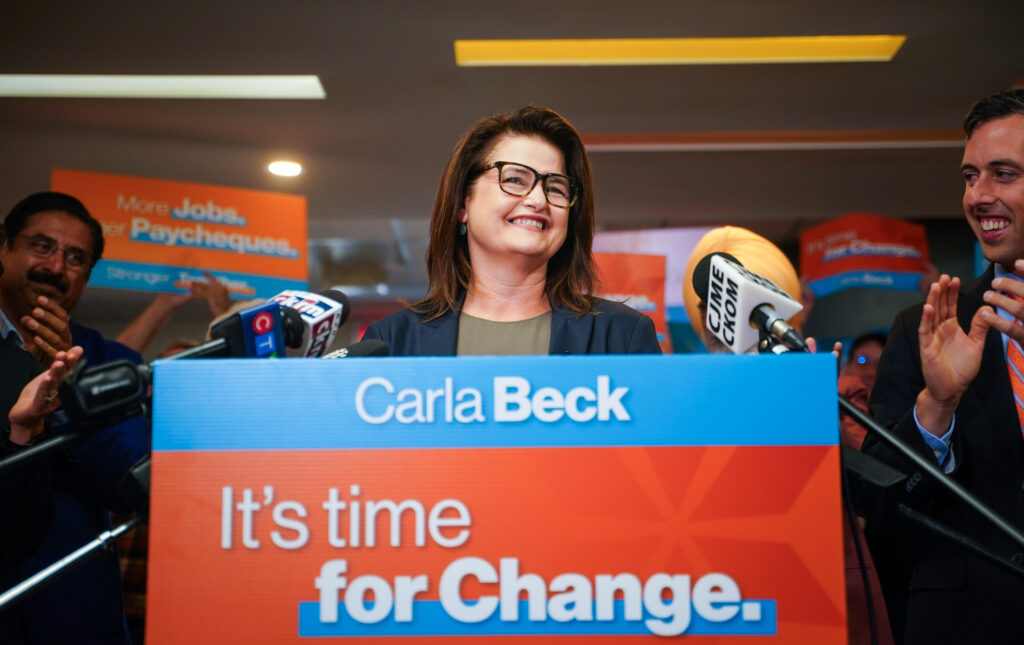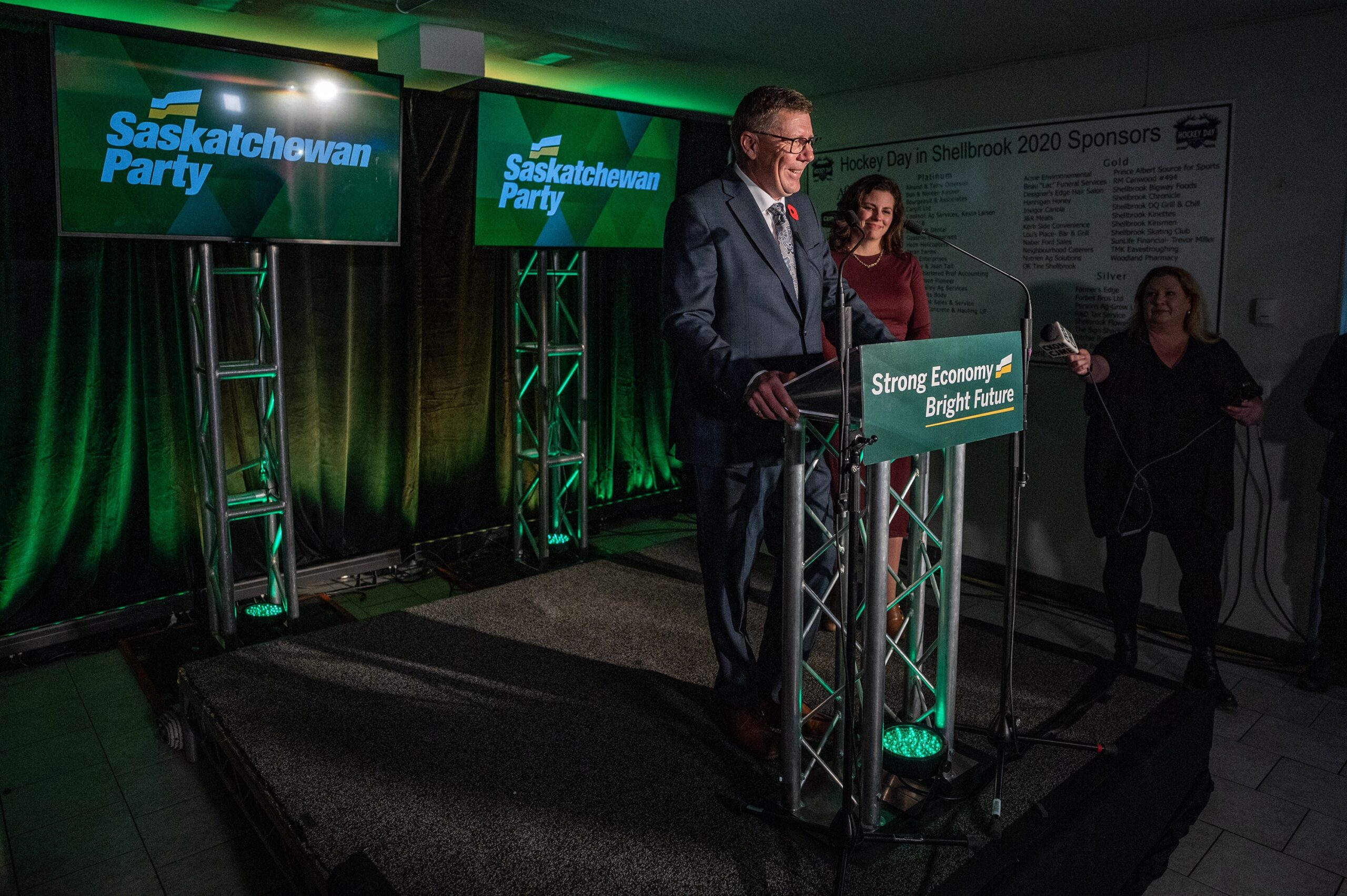Closer result sees NDP make significant electoral gains in Regina and Saskatoon
Premier Scott Moe and the Saskatchewan Party were re-elected to a fifth straight majority government on Monday night. The night’s results concluded a short 27-day campaign that began on October 1st. With some mail-in ballots still to be counted, the Saskatchewan Party was elected or leading in 35 seats, while the NDP was elected or leading in 26. The NDP’s gains came in large urban areas, securing every seat in Regina, and all but two in Saskatoon. The New Democrats nearly doubled their seat total from the 14 it had at the dissolution of the legislature, but with 31 rural seats and only 30 urban seats in the province, the NDP’s path to victory had slim margins. They needed to pick up two seats each in Moose Jaw and Prince Albert but came up short in those ridings. Despite that, this is the closest election result for the Sask. Party since it was first elected.
The province’s electoral office said early voting last week amounted to 273,010, meaning about one-third of Saskatchewan’s 810,816 registered voters had already cast their ballots. Based on Election Saskatchewan’s preliminary vote count, turnout was about 53 per cent of eligible voters.
As of Tuesday morning, there were still 20,417 mail-in ballots that have yet to be counted. With five ridings within 300 votes, there is still potential for some shifting in the numbers once those are counted. This could be potentially important in the five ridings where the candidates remain within 300 votes of each other:
- Saskatoon Willowgrove—Sask. Party ahead by 255 votes
- Saskatoon Westview—Sask. Party ahead by 31 votes
- Saskatoon Southeast—NDP ahead by 292 votes
- Saskatoon Silverspring—NDP ahead by 258 votes
- Prince Albert Northcote—Sask. Party ahead by 125 votes
Premier Scott Moe addressed a roomful of supporters in his home riding of Shellbrook on Monday night, saying to those who chose to re-elect his government across the province “words can never express…thank you, thank you, thank you”. But his celebrations were not without reflection, as he noted “Our team has heard your message… we must do better, and we most certainly will.”
NDP Leader Carla Beck addressed supporters in Regina shortly after the Monday night call, trying to keep an upbeat tone given her party’s comparative gains, it was impossible to not detect some disappointment: “Now we might not have crossed the finish line first tonight, but my friends, we have changed the landscape in this province… Let me tell you, tonight is not the end,”

Campaign recap
The results mark the end of a campaign that for the first two weeks looked like it might be a complete snoozefest. Both main party leaders spent the beginning of the campaign announcing (or re-announcing in the NDP’s case) their campaign commitments. Moe started the campaign with a succession of promises to address affordability and cost of living, including cutting income taxes, increasing support for first-time homebuyers, expanding coverage for adults with diabetes, and announcing a tax credit for fertility treatments. The NDP’s campaign commitments focused on affordability measures, health care, and increasing education spending.
The leaders debate on October 16th was a near non-event, with neither Moe nor NDP leader Carla Beck landing any knockout blows. The campaign winds shifted the day after the debate, when Moe announced his re-elected government’s ‘first order of business’ would be to introduce a “change room” policy in Saskatchewan schools that ensure biological boys and girls were separated in school change rooms. The announcement of the policy likely hurt the Saskatchewan Party in the province’s two biggest cities, particularly with female voters, and perhaps especially with millennial women with school-aged children.
While much of the focus in the last two weeks was on Moe’s change room policy announcement, the Saskatchewan Party’s strength in rural Saskatchewan was ultimately enough to carry the party to another majority government. With the party’s fifth straight win, the Saskatchewan Party will make history: by the end of this next term of government, the Saskatchewan Party will be the longest serving government in the province’s history, surpassing the Tommy Douglas-Woodrow Lloyd CCF/NDP government that served from 1944-1962.
Race results and upsets
In an election that highlighted the ever growing rural-urban divide in the province—and between parties—Ken Cheveldayoff (Saskatoon Willowgrove) and David Buckingham (Saskatoon Westview) were able to hang on to critical urban seats for the Saskatchewan Party.
Saskatchewan Party MLA and former cabinet minister Gene Makowsky was defeated in the Regina University constituency by Sally Housser, a former NDP staffer and public affairs professional. This race was expected to be one to watch, as the NDP put significant resources into supporting Housser. Regina Rochdale MLA and former cabinet minister Laura Ross was defeated by Joan Pratchler (NDP).
Environment Minister and long-time Saskatchewan Party MLA Christine Tell was not re-elected in the Regina Wascana Plains constituency Monday night, losing to the NDP’s Brent Blakley. Tell had held the seat since 2007, being re-elected in 2011, 2016, and 2020. Blakley enters the legislature as a political newcomer. His previous experience includes a 35-year career as an educator.
Paul Merriman, the former Minister of corrections, policing and public safety lost his seat in Saskatoon Silverspring by 258 votes—as of Tuesday morning. Picking up the seat was the NDP’s candidate Hugh Gordon, who is also entering politics for the first time being a retired RCMP officer and small business owner in the past.
Bronwyn Eyre, former Minister of Justice and Attorney General also failed to retain her seat of Saskatoon Stonebridge, by just over 700 votes. Incoming NDP MLA Darcy Warrington picked up the seat for his party, coming from an educational background in the area. Saskatoon Stonebridge was one of the ridings effected most by redistribution with much of its rural area being cut out and distributed to the constituencies of Batoche, Dakota-Arm River and Humboldt-Watrous.
Saskatchewan Party incumbent for Saskatoon Churchill-Wildwood Lisa Lambert was beaten by over 1100 votes, giving the NDP one of their largest win margins last night. Lambert was first elected in 2016 and held multiple roles within the Saskatchewan Party government, including deputy whip, legislative secretary for the minister of parks, culture and sport, while serving on four separate committees. Taking over the riding will be NDP’s Keith Jorgenson who is a former teacher and business owner.
Among the new MLAs for the Saskatchewan Party are Sean Wilson (Canora-Pelly), Jamie Martens (Martensville-Blairmore), Eric Schmalz (Saskatchewan Rivers), Kevin Kasun (Prince Albert Carlton), Megan Patterson (Moose Jaw Wakamow), and Terri Bromm (Carrot River Valley).
The NDP also gained back the northern riding of Athabasca, which it lost to the Saskatchewan Party in a 2022 byelection.
What’s next for another Saskatchewan Party government
Premier Moe will be putting together a cabinet in the coming days, which will be full of new faces. With the defeat of several cabinet ministers in the cities and the retirements of other longtime MLAs, Moe will have to put together a cabinet that balances experience, geographical representation, and political considerations. A new finance minister will be appointed after Donna Harpauer’s retirement, and there will be new ministers of environment, corrections and policing, and Justice and Attorney General.
The close election result means the Saskatchewan Party will be operating in uncharted territory for the next four years. The smaller margin of victory may not bring the usual sense of comfort that the government has gotten used to when it returns to the legislature in the coming weeks and meets for the first time with its smaller caucus. Legislative proceedings will become much more important to keep an eye on as every vote in the Legislative Assembly will require nearly every member to be present.
The smaller caucus for the Saskatchewan Party also leaves little room for departures over the next four years. Since its election in 2007, the Saskatchewan Party government has regularly seen MLAs leave caucus for new opportunities, and, sadly, has seen members pass away while in office. Any departures could weaken the Saskatchewan Party’s majority in the Legislature, especially in Saskatoon, where the party has historically performed poorly in by-elections.
Meanwhile, Beck and the Saskatchewan NDP will spend the next four years nipping at the heels of the Saskatchewan Party while trying to carry the momentum it found during this election and prove its staying power, rather than being brushed off as a benefactor of the incumbent fatigue that has been seen across the country.
When the Saskatchewan Party government returns to office it can be expected to quickly implement its campaign promises, including measures to address affordability and health care. If Moe’s election night remarks are any indication, his government may also look to make improvements in education and other policy areas aimed at winning back voters in Regina and Saskatoon. The Saskatchewan Party will also continue its focus on the Saskatchewan 2030 Growth Plan, zeroing in on growing the province’s economy and industries, and reaching goals related to population growth, increasing jobs, and growing the province’s exports to the rest of the world.
For more insights on the Saskatchewan election, connect with Principal Dale Richardson.
